John Everett Millais
Sir John Everett Millais | |
|---|---|
 Self-portrait by Millais, 1881. | |
| Born | 8 June 1829 Southampton, Hampshire, England |
| Died | 13 August 1896 (aged 67) Kensington, London, England |
| Nationality | British |
| Education | Royal Academy of Art |
| Known for | Painting, drawing, printmaking |
Notable work | Ophelia; Christ in the House of His Parents |
| Movement | Pre-Raphaelite Brotherhood |
| Spouse(s) | Euphemia Gray (m. 1855) |
Sir John Everett Millais, 1st Baronet, PRA (UK: /ˈmɪleɪ/ MIL-ay, US: /mɪˈleɪ/ mil-AY;[1][2] 8 June 1829 – 13 August 1896) was an English painter and illustrator who was one of the founders of the Pre-Raphaelite Brotherhood.[3] He was a child prodigy who, aged eleven, became the youngest student to enter the Royal Academy Schools. The Pre-Raphaelite Brotherhood was founded at his family home in London, at 83 Gower Street (now number 7). Millais became the most famous exponent of the style, his painting Christ in the House of His Parents (1850) generating considerable controversy, and painting perhaps the embodiment of the school, Ophelia, in 1850–51.
By the mid-1850s, Millais was moving away from the Pre-Raphaelite style to develop a new form of realism in his art. His later works were enormously successful, making Millais one of the wealthiest artists of his day, but some former admirers including William Morris saw this as a sell-out (Millais notoriously allowed one of his paintings to be used for a sentimental soap advertisement). While these and early 20th-century critics, reading art through the lens of Modernism, viewed much of his later production as wanting, this perspective has changed in recent decades, as his later works have come to be seen in the context of wider changes and advanced tendencies in the broader late nineteenth-century art world, and can now be seen as predictive of the art world of the present.
Millais's personal life has also played a significant role in his reputation. His wife Effie was formerly married to the critic John Ruskin, who had supported Millais's early work. The annulment of the marriage and her wedding to Millais have sometimes been linked to his change of style, but she became a powerful promoter of his work and they worked in concert to secure commissions and expand their social and intellectual circles.
Early life[edit]
Millais was born in Southampton, England in 1829, of a prominent Jersey-based family. His parents were John William Millais and Emily Mary Millais. Most of his early childhood was spent in Jersey, to which he retained a strong devotion throughout his life. The author Thackeray once asked him "when England conquered Jersey." Millais replied "Never! Jersey conquered England."[4] The family moved to Dinan in Brittany for a few years in his childhood.
His mother's "forceful personality" was the most powerful influence on his early life. She had a keen interest in art and music, and encouraged her son's artistic bent, promoting the relocating of the family to London to help develop contacts at the Royal Academy of Art. He later said "I owe everything to my mother."[5]
His artistic talent won him a place at the Royal Academy schools at the unprecedented age of eleven. While there, he met William Holman Hunt and Dante Gabriel Rossetti with whom he formed the Pre-Raphaelite Brotherhood (known as the "PRB") in September 1848 in his family home on Gower Street, off Bedford Square.
Pre-Raphaelite works[edit]
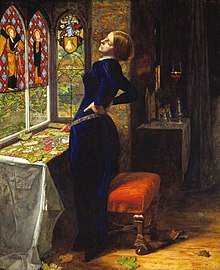
Millais's Christ in the House of His Parents (1849–50) was highly controversial because of its realistic portrayal of a working class Holy Family labouring in a messy carpentry workshop. Later works were also controversial, though less so. Millais achieved popular success with A Huguenot (1851–52), which depicts a young couple about to be separated because of religious conflicts. He repeated this theme in many later works. All these early works were painted with great attention to detail, often concentrating on the beauty and complexity of the natural world. In paintings such as Ophelia (1851–52) Millais created dense and elaborate pictorial surfaces based on the integration of naturalistic elements. This approach has been described as a kind of "pictorial eco-system." Mariana is a painting that Millais painted in 1850–51 based on the play Measure for Measure by William Shakespeare and the poem of the same name by Alfred, Lord Tennyson from 1830. In the play, the young Mariana was to be married, but was rejected by her betrothed when her dowry was lost in a shipwreck.
This style was promoted by the critic John Ruskin, who had defended the Pre-Raphaelites against their critics. Millais's friendship with Ruskin introduced him to Ruskin's wife Effie. Soon after they met, she modelled for his painting The Order of Release. As Millais painted Effie, they fell in love. Despite having been married to Ruskin for several years, Effie was still a virgin. Her parents realised something was wrong and she filed for an annulment.
The Order of Release (1852–53) Tate Britain, London
Ophelia (1851–52) Tate Britain, London
The Return of the Dove to the Ark (1851)
Ashmolean Museum, Oxford
Family[edit]
In 1855, after her marriage to Ruskin was annulled, Effie and John Millais married. He and Effie eventually had eight children: Everett, born in 1856; George, born in 1857; Effie, born in 1858; Mary, born in 1860; Alice, born in 1862; Geoffroy, born in 1863; John in 1865; and Sophie in 1868. Their youngest son, John Guille Millais, became a naturalist, wildlife artist, and Millais's posthumous biographer. Their daughter Alice, later Alice Stuart-Wortley, was a close friend and muse of the composer Edward Elgar, and is thought to have been an inspiration for themes in his Violin Concerto.[6]
Effie's younger sister Sophie Gray sat for several pictures by Millais, prompting some speculation about the nature of their apparently fond relationship.[7]
Later works[edit]

After his marriage, Millais began to paint in a broader style, which was condemned by Ruskin as "a catastrophe." It has been argued that this change of style resulted from Millais's need to increase his output to support his growing family. Unsympathetic critics such as William Morris accused him of "selling out" to achieve popularity and wealth. His admirers, in contrast, pointed to the artist's connections with Whistler and Albert Moore, and influence on John Singer Sargent. Millais himself argued that as he grew more confident as an artist, he could paint with greater boldness. In his article "Thoughts on our art of Today" (1888) he recommended Velázquez and Rembrandt as models for artists to follow. Paintings such as The Eve of St. Agnes and The Somnambulist clearly show an ongoing dialogue between the artist and Whistler, whose work Millais strongly supported. Other paintings of the late 1850s and 1860s can be interpreted as anticipating aspects of the Aesthetic Movement. Many deploy broad blocks of harmoniously arranged colour and are symbolic rather than narratival. From 1862, the Millais family lived at 7 Cromwell Place, Kensington, London.[8]
Later works, from the 1870s onwards demonstrate Millais's reverence for Old Masters such as Joshua Reynolds and Velázquez. Many of these paintings were of an historical theme. Notable among these are The Two Princes Edward and Richard in the Tower (1878) depicting the Princes in the Tower, The Northwest Passage (1874) and the Boyhood of Raleigh (1871). Such paintings indicate Millais's interest in subjects connected to Britain's history and expanding empire. Millais also achieved great popularity with his paintings of children, notably Bubbles (1886) – famous, or perhaps notorious, for being used in the advertising of Pears soap – and Cherry Ripe. His last project (1896) was to be a painting entitled "The Last Trek." Based on his illustration for his son's book, it depicted a white hunter lying dead in the African veldt, his body contemplated by two Africans.
Landscapes 1870–1892[edit]
His many landscape paintings of this period usually depict difficult or dangerous terrain. The first of these, Chill October (1870) was painted in Perth, near his wife's family home. Chill October (Collection of Andrew Lloyd Webber) was the first of the large-scale Scottish landscapes Millais painted periodically throughout his later career. Usually autumnal and often bleakly unpicturesque, they evoke a mood of melancholy and sense of transience that recalls his cycle-of-nature paintings of the later 1850s, especially Autumn Leaves (Manchester Art Gallery) and The Vale of Rest (Tate Britain), though with little or no direct symbolism or human activity to point to their meaning.
In 1870 Millais returned to full landscape pictures, and over the next twenty years painted a number of scenes of Perthshire where he was annually found hunting and fishing from August until late into the autumn each year. Most of these landscapes are autumnal or early winter in season and show bleak, dank, water-fringed bog or moor, loch, and riverside. Millais never returned to "blade by blade" landscape painting, nor to the vibrant greens of his own outdoor work in the early fifties, although the assured handling of his broader, freer later style is equally accomplished in its close observation of scenery. Many were painted elsewhere in Perthshire, near Dunkeld and Birnam, where Millais rented grand houses each autumn to hunt and fish. Christmas Eve, his first full landscape snow scene, painted in 1887, was a view looking towards Murthly Castle.
Illustrations[edit]
Millais was also very successful as a book illustrator, notably for the works of Anthony Trollope and the poems of Tennyson. His complex illustrations of the parables of Jesus were published in 1864. His father-in-law commissioned stained-glass windows based on them for Kinnoull parish church, Perth. He also provided illustrations for magazines such as Good Words. As a young man Millais frequently went on sketching expeditions to Keston and Hayes. While there he painted a sign for an inn where he used to stay, near to Hayes church (cited in Chums annual, 1896, page 213).
Academic career and baronetage[edit]
Millais was elected as an associate member of the Royal Academy of Arts in 1853, and was soon elected as a full member of the Academy, in which he was a prominent and active participant. In July 1885, Queen Victoria created him a baronet, of Palace Gate, in the parish of St Mary Abbot, Kensington, in the county of Middlesex, and of Saint Ouen, in the Island of Jersey,[9] making him the first artist to be honoured with a hereditary title. After the death of Lord Leighton in 1896, Millais was elected President of the Royal Academy. He died later in the same year from throat cancer. He was buried in the crypt of St Paul's Cathedral. Additionally, between 1881 and 1882, Millais was elected and acted as the president of the Royal Birmingham Society of Artists.[10]
Legacy[edit]
When Millais died in 1896, the Prince of Wales (later to become King Edward VII) chaired a memorial committee which commissioned a statue of the artist.[11] The statue, by Thomas Brock, was installed at the front of the National Gallery of British Art (now Tate Britain) in the garden on the east side in 1905. On 23 November that year, the Pall Mall Gazette called it "a breezy statue, representing the man in the characteristic attitude in which we all knew him."[11] In 1953, Tate director Norman Reid attempted to have it replaced by Auguste Rodin's John the Baptist, and in 1962 again proposed its removal, calling its presence "positively harmful." His efforts were frustrated by the statue's owner, the Ministry of Works. Ownership was transferred from the Ministry to English Heritage in 1996, and by them in turn to the Tate.[11] In 2000, under Stephen Deuchar's directorship, the statue was removed to the side of the building to welcome visitors to the refurbished Manton Road entrance.[11] In 2007 the artist was the subject of a major retrospective at Tate Britain, London visited by 151,000 people.[12] The exhibition then traveled to the Van Gogh Museum, Amsterdam, followed by venues in Fukuoka and Tokyo, Japan, and seen by over 660,000 visitors in total.
Millais's relationship with Ruskin and Effie has been the subject of several dramas, beginning with the silent film The Love of John Ruskin from 1912. There have also been stage and radio plays and an opera. The 2014 film, Effie Gray, written by Emma Thompson, featured Tom Sturridge as Millais. The Pre-Raphaelites have been the subjects of two BBC period dramas. The first, entitled The Love School, was shown in 1975, starring Peter Egan as Millais. The second was Desperate Romantics, in which Millais is played by Samuel Barnett. It was first broadcast on BBC 2 Tuesday, 21 July 2009.[13]
Gallery[edit]
A Huguenot on St Bartholomew's Day (1851–52)
The Vale of Rest (1858) Tate Britain, London
The Black Brunswicker (1860)
The Eve of Saint Agnes (1863)
HM The QueenEsther (1865) Private Collection
Vanessa (1868)
Liverpool Museums ServiceChill October (1870), private collection
The Two Princes Edward and Richard in the Tower (1878)
Picture Gallery of Royal Holloway College
Notes and references[edit]
- ^ Wells, John C. (2008). Longman Pronunciation Dictionary (3rd ed.). Longman. ISBN 978-1-4058-8118-0.
- ^ Jones, Daniel (2011). Roach, Peter; Setter, Jane; Esling, John (eds.). Cambridge English Pronouncing Dictionary (18th ed.). Cambridge University Press. ISBN 978-0-521-15255-6.
- ^ . Dictionary of National Biography (1st supplement). London: Smith, Elder & Co. 1901.
- ^ cited in Chums annual, 1896, page 213
- ^ J. N. P. Watson, Millais: three generations in nature, art & sport, Sportsman's Press, 1988, p.10
- ^ Kennedy, Michael (1984). Liner notes to EMI CD CD-EMX-2058
- ^ Suzanne Fagence Cooper (2010) The Model Wife
- ^ "John Everett Millais 1829–1896, Tate Gallery, London". Tate.org.uk. Retrieved 29 January 2014.
- ^ "No. 25490". The London Gazette. 14 July 1885. p. 3239.
- ^ The Year's Art. 1904.
- ^ a b c d Birchall, Heather. "Sir Thomas Brock 1847–1922", Tate online, February 2002. Retrieved 5 April 2008.
- ^ https://www.tate.org.uk/whats-on/tate-britain/exhibition/millais
- ^ "BBC Drama Production presents Desperate Romantics for BBC Two" (Press release). BBC. 7 August 2008. Retrieved 23 October 2010.
Further reading[edit]
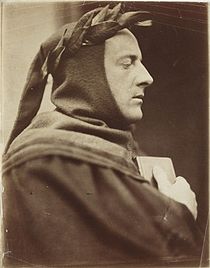 | |
- Anonymous (1873). Cartoon portraits and biographical sketches of men of the day. Illustrated by Waddy, Frederick. London: Tinsley Brothers. pp. 8–9. Retrieved 28 December 2010.
- Baldry, A. L. Sir John Everett Millais (London, G. Bell & Sons, 1908).
- Barlow, Paul Time Present and Time Past: The Art of John Everett Millais, Ashgate 2005.
- Bennett, Mary. Footnotes to the Millais Exhibition (Walker Art Gallery (Liverpool Bulletin, No 12 1967).
- Bennett, Mary (catalogue) (Walker Art Gallery and Royal Academy catalogue 1967).
- Campbell-Johnston, R (25 September 2007). "Master of Victorian values". Visual Arts. London: The Times. Retrieved 24 September 2007.
- Daly, G (1989). Pre-Raphaelites in love. New York: Ticknor & Fields. ISBN 0-89919-450-8. OCLC: 18463706.
- Eggeling, Dr Joe. Millais and Dunkeld The story of Millais's Landscapes (1985).
- Goldman, Paul. Beyond Decoration: the Illustrations of John Everett Millais. Pinner, Middlesex: Private Libraries Association, 2005
- Lutyens (ed). Millais and the Ruskins 1967.
- Lutyens, M. Letters from John Everett Millais, Bart P.R.A. and William Holman Hunt. O.M. (The Walpole Society, 1972–4).
- Mancoff, D. N. (ed). John Everett Millais beyond the Pre Raphaelite Brotherhood (London and New Haven, 2001).
- Millais, John Guille. The Life and Letters of John Everett Millais. Volume 1, Volume 2 (London: Methuen, 1899).
- National Portrait Gallery catalogue, 1999.
- Rosenfeld, Jason and Alison Smith (Tate Britain catalogue, 2007).
- Rosenfeld, Jason. John Everett Millais. Phaidon Press Ltd., 2012.
- Reynolds, Matthew (24 October 2007). "Millais's high drama and low designs". The Times. London.
- Spielmann, Marion. Notes on Millais Exhibition R.A. 1898.
- F.G. Stephens. Grosvenor 1886 Exhibition of the works of John Everett Millais, Bt (Notes from a catalogue, 1886)
- Warner, Malcolm. The Drawings of John Everett Millais (Arts Council catalogue, 1979).
- Williamson, Audrey (1976). Artists and Writers in Revolt – The Pre-Raphaelites.
External links[edit]
| Wikimedia Commons has media related to John Everett Millais. |
- 153 paintings by or after John Everett Millais at the Art UK site
- Millais, John Everett. Spring. Lady Lever Art Gallery.
- National Museums Liverpool important Millais collection
- Millais's Ophelia in focus on Tate Online
- Tate Shots: Millais's Isabella
- smARThistory: Christ in the House of His Parents and Ophelia – Khan Academy
- Birmingham Museums & Art Gallery's Pre-Raphaelite Online Resource includes almost 200 paintings on canvas and works on paper by Millais
| Cultural offices | ||
|---|---|---|
| Preceded by The Lord Leighton | President of the Royal Academy 1896 | Succeeded by Sir Edward Poynter |
| Baronetage of the United Kingdom | ||
| New creation | Baronet (of Palace Gate and St Ouen) 1885–1896 | Succeeded by Everett Millais |
- Baronets in the Baronetage of the United Kingdom
- 19th-century English painters
- English male painters
- English illustrators
- People from Southampton
- English people of Norman descent
- Pre-Raphaelite painters
- Royal Academicians
- Burials at St Paul's Cathedral
- Deaths from laryngeal cancer
- Deaths from cancer in England
- Artists' Rifles officers
- 1829 births
- 1896 deaths
- Royal Society of Portrait Painters
- Child artists
- Recipients of the Pour le Mérite (civil class)
- Millais family
- Members of the Athenaeum Club, London






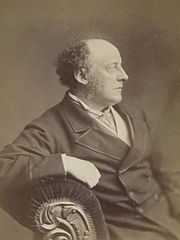

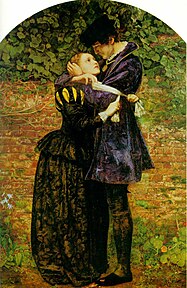

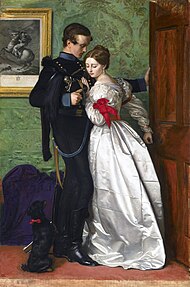

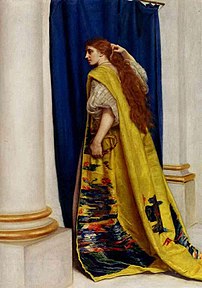
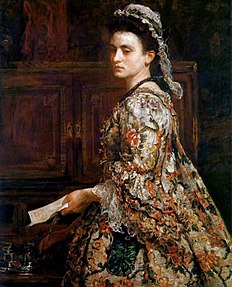




No comments:
Post a Comment